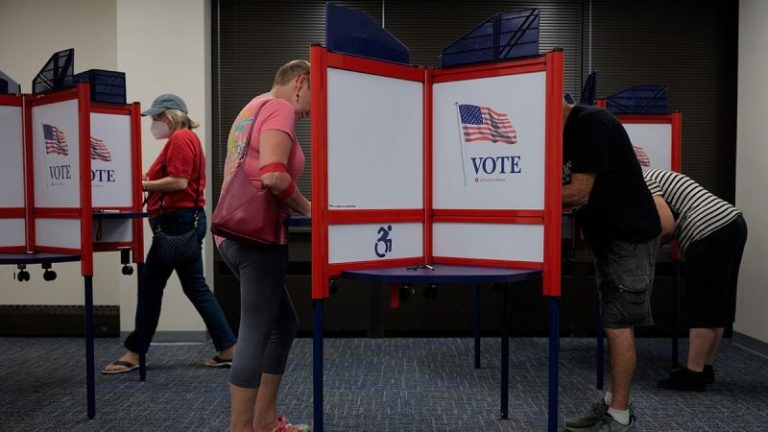This week began on a strong note, with emerging signs that US-China tensions could ease and White House Economic Advisor Kevin Hassett’s suggestion that the federal government shutdown could soon end.
US stocks rallied broadly, led by small caps and semiconductors, with the PHLX Semiconductor Sector (INDEXNASDAQ:SOX) hitting an all-time high amid reduced concerns about regional bank credit quality.
On Tuesday (October 21), hotter-than-expected Canadian inflation data weighed on the S&P/TSX Composite Index (INDEXTSI:OSPTX), while the Nasdaq Composite (INDEXNASDAQ:.IXIC) outperformed.
Wednesday (October 22) saw profit taking in high-growth names as Tesla (NASDAQ:TSLA) and IBM (NYSE:IBM) reported after the bell, and as reports of potential new US export curbs on China pressured equities.
IBM beat revenue forecasts with US$9.5 billion in artificial intelligence (AI) revenue, but offered cautious guidance, leading its share price to fall after-hours. Tesla missed revenue estimates, with margins falling to 5.8 percent due to price cuts and reduced regulatory credits, despite record deliveries. CEO Elon Musk reiterated medium-term goals in AI, autonomy and robotics, though the firm didn’t update its financial guidance. Tesla shares also dropped after hours.
Despite the pullback, the tech sector rebounded sharply on Thursday (October 23), driven by optimism about AI and cloud infrastructure. Quantum computing companies such as IonQ (NASDAQ:IONQ), Rigetti Computing (NASDAQ:RGTI) and D-Wave Quantum (NYSE:QBTS) surged on reports of increased US government funding.
North of the border, Canadian Prime Minister Mark Carney and Ontario Premier Doug Ford unveiled a C$3 billion joint investment in small modular reactors at the Darlington site, located east of Toronto in Bowmanville.
Later, Intel (NASDAQ:INTC) surpassed expectations with a 3 percent year-on-year revenue increase, reaching US$13.7 billion, with gross margins doubling to 38 percent. The demand for AI accelerators and x86 processors contributed to these strong results. CEO Lip-Bu Tan expressed confidence in continuing AI-driven compute demand.
Following the announcement, shares rose and opened nearly 5 percent higher the next day.
Intel’s standout earnings boosted sentiment heading into Friday. Markets opened higher after delayed US inflation data came in cooler than expected, showing easing underlying pressures and reinforcing expectations for another Fed rate cut next week. Tech stocks led the advance once again.
3 tech stocks that moved markets this week
1. Micron Technology (NASDAQ:MU)
Micron Technology shares rose 4.46 percent this week, hitting a record high above US$214 on Monday (October 20) after analysts at Barclays (NYSE:BCS) raised their price target from US$195 to US$240, citing robust earnings and margin expansion as signs of operational strength. The company has reported surging demand for its high-bandwidth memory chips, with supply fully sold out through 2026. Other semiconductor stocks, such as ON Semiconductor (NASDAQ:ON) and KLA (NASDAQ:KLAC), also gained, reflecting broad semiconductor strength.
2. Apple (NASDAQ:AAPL)
Apple’s share price is up 2.7 percent for the week, boosted by an overall bullish sentiment for high-value tech stocks, as well as momentum from strong M5 MacBook demand and solid sales of the iPhone 17 in the US and China.
CEO Tim Cook later announced the opening of the company’s Texas manufacturing facility on Thursday, two months ahead of schedule, further boosting sentiment.
3. NVIDIA (NASDAQ:NVDA)
Top AI stock NVIDIA saw gains of 1.67 percent this week following a joint announcement with Taiwan Semiconductor Manufacturing Company (NYSE:TSM). The companies said the first Blackwell wafer has been produced in the US at Taiwan Semiconductor’s semiconductor fab in Phoenix.
It is the first of its kind to be domestically manufactured in recent American history.
NVIDIA remains the bellwether for the AI sector, and its share price performance is widely regarded as a barometer for risk-on sentiment in the AI and tech sectors, with its share price movements often reflecting investor appetite for growth and optimism about the future of AI-driven innovation.
Micron Technology, NVIDIA and Apple performance, October 21 to 24, 2025.
Chart via Google Finance.
Tech ETF performance
This week, the iShares Semiconductor ETF (NASDAQ:SOXX) advanced by 1.83 percent, while the Invesco PHLX Semiconductor ETF (NASDAQ:SOXQ) saw a weekly gain of 1.91 percent.
The VanEck Semiconductor ETF (NASDAQ:SMH) increased by 1.59 percent.
Other tech market news
- Amazon Web Services experienced a major outage this week, raising concerns about cloud infrastructure resilience and spotlighting the critical dependency on hyperscale providers.
Tech news to watch next week
Next week, investors will be eyeing interest rate decisions from the Bank of Canada and the US Federal Reserve. The Bank of Canada is expected to hold rates steady, reflecting ongoing cautiousness amid cooling inflation, while US investors are betting on a rate cut from the the country’s central bank.
Earnings results from tech giants will also be closely watched, with Alphabet (NASDAQ:GOOGL), Microsoft and Meta reporting on Wednesday (October 29), and Apple and Amazon on Thursday (October 30).
Strong beats or cautious guidance from these heavyweight companies could either boost confidence in the tech sector’s growth trajectory or temper enthusiasm in the final quarter of 2025.
Securities Disclosure: I, Meagen Seatter, hold no direct investment interest in any company mentioned in this article.
This post appeared first on investingnews.com










